For those of you who missed it - Newsday reported on a juvenile Peregrine Falcon which was injured during a fall at the Federal Courthouse in Islip recently. The bird had only minor injuries and is being rehabbed - more importantly though is that this proves the existence of a Peregrine nest on the top of the Courthouse (some 80 feet high). According to the article, there are only two other spots on the island that have active nesting Peregrines (the Robert Moses Bridge and Nassau University Medical Center). Let's hope that in the near future there are many more - perhaps at the big Coast Guard tower in Hampton Bays or the adjacent Ponquogue Bridge where I've seen multiple Peregrine's? (see photo above and below).
Anyway, here is the full article, via Newsday:
__________________________________________________________________________________
A female baby peregrine falcon injured itself and had to be trapped and taken to a veterinarian Wednesday, after one of her first attempts to fly from a nest atop the federal courthouse in
Central Islip, officials said.
The presence of a baby falcon, or an eyas as it is called, surprised court officials, though they knew a female and male falcon had taken up residence near the top of the courthouse's nine-story entrance rotunda and scared away the flocks of pigeons that had been roosting on the building's many ledges.
The pigeons' droppings, encrusting the ledges, had become a headache for building managers, costing "thousands of dollars" annually to clean up, according to William Schrader, the courthouse manager for the federal General Service's Administration.
"They solved our pigeon problem and helped the taxpayers," Schrader said Wednesday, adding he was delighted now by the presence of one or more baby falcons.
Bird experts had told GSA officials that it was likely that the male and female peregrine falcons might be caring for young because the ground under the nesting sight was occasionally littered with the heads of small birds such as starlings and sparrows, GSA Long Island manager,
Enrico Caruso, said.
While the adult falcons could be seen perching on the courthouse, their nest, if any, was in an area of the rotunda that was very difficult to access, behind a high wall, the only path to which is a precarious journey between the skylights that provide light for the rotunda.
And when the rotunda recently began to leak, maintenance workers were divebombed by the falcons, apparently guarding the nest and babies, and had to retreat for their safety, Schrader said.
Wildlife officials also said that the falcons are a protected species in New York State and should be treated with care, GSA officials said.
"But we're happy to learn to live with them and will work something out with the leaks," Schrader said.
The licensed wildlife trapper called in by officials Wednesday, Bobby Horvath of
Massapequa, said it was likely that the young female peregrine falcon was making one of her first flights and banged into the courthouse, and then fell to the ground.
She was hopping around on the ground unable to fly when he caught her in a net, said Horvath, a New York City firefighter who operates Wildlife in Need of Rescue and Rehabilitation in
Massapequain his spare time.
He said it appeared that the baby falcon had a minor injury to her left wing and her chances for complete recovery were very good.
Horvath said that he identified one other uninjured baby peregrine resting on the eighth-floor ledge of the courthouse and speculated there may be others that the parents are still guarding in the rotunda nest.
Horvath said thatperegrines are among the world's fastest creatures, able to dive at 200 miles per hour, live on catching smaller birds, and like to nest in high cliffs or on tall manmade structures.
He said there have been two other publicly identified peregrine nests on Long Island, one on the
Robert Moses bridge and the other on the
Nassau County Medical Center.
Early yesterday evening the injured baby falcon waited for a veterinarian to X-ray her while she contentedly munched on a thawed frozen quail, Horvath said.







































